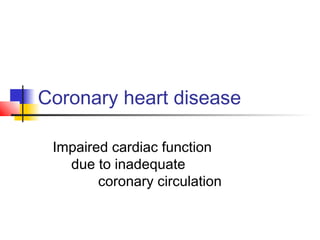
Ischemic heart disease
- 1. Coronary heart disease Impaired cardiac function due to inadequate coronary circulation
- 2. Commonest cause- CAD End result of accumulation of atheromatous plaques in coronary arteries
- 3. Non-atherosclerotic causes Coronary vasospasm- Prinzmetal angina Cardiac syndrome X- common in women Severe LV hypertrophy Severe aortic stenosis or regurgitation Congenital coronary artery anomaly Coronary artery emboli/dissection Increased cardiac demand- tachycardia, anemia, hyperthyroidism
- 4. Risk factors for atherosclerosis Non-modifiable- age, sex, family history Modifiable- Smoking Hypercholesterolemia- LDL, lipoprotein a Hypertension- systolic > diastolic Hyperglycemia- diabetes mellitus Type A behaviour- stress High fibrinogen, factor VII Hyperhomocysteinemia Obesity, sedentary lifestyle CRI
- 5. Pathophysiology Atherosclerosis is nearly universal & starts before adulthood, leading to plaque formation Plaques cause narrowing of coronary arteries Stable plaque causes predictable angina Unstable plaque ruptures, activating clotting system & thrombus formation, that impairs coronary blood flow causing unstable angina or MI MI heals with scarring, causing impairing contractility & increasing stiffness, leading to HF- acute/chronic Ischemic areas & scars are prone to cause ventricular arrythmias, leading to sudden death
- 6. Manifestations Asymptomatic Angina- Acute- unstable- unpredictable Chronic- stable- predictable Myocardial infarction- Non ST elevated- NSTEMI ST elevated- STEMI Acute LVF Ischemic cardiomyopathy- CHF Sudden cardiac death
- 7. Clinical presentation Angina pectoris- Precordial/retrosternal/epigastric pain Described as tightness, squeezing, choking, indigestion Duration- <20 mins Radiation to left arm, shoulder, jaw Precipitated by exertion, stress, meal, cold, sex Relieved by rest or sublingual nitroglycerin Associated SOB, sweating, nausea, dizziness/syncope Unstable angina- Angina at rest, new-onset, more severe, increased frequency Myocardial infarction- Duration- >20 mins, not relieved by NTG
- 8. Evaluation Examination- HR, BP, ±S3/S4, murmur of MR Ix- Disease- ECG-ST elevation/depression, CxR, Stress test- TMT/radionuclide/ECHO, ECHO- regional wall-motion abnormality, Coronary angiography- CT or conventional, ±IVUS Risk factors- FBS, lipid profile, creatinine Precipitating factors- Hb, TSH
- 9. TMT- Treadmill test Bruce protocol- Increases treadmill speed & elevation every 3 minutes Indication- To confirm diagnosis of angina & determine severity To assess prognosis in patients with known CAD Screen those at high risk of CAD Interpretation- >1 mm flat or downsloping ST depression Severe disease- >2 mm depression, <6 mins. of exercise, HR <70% predicted for age & hyper/hypotension
- 10. Coronary angiography For definitive diagnosis of CAD Indication- if PTCA/CABG an option- Limiting stable angina on adequate medical Rx High-risk disease- ACS or high-risk TMT Concomitant aortic valve disease Older patients undergoing valve surgery Recurrence of angina after PTCA/CABG Cardiac failure with surgically correctable lesion Survivors of SCD or VT Chest-pain or cardiomyopathy of unknown etiology
- 11. Treatment Medical- Aspirin- anti-thrombotic-1° & 2° prevention β-blockers- decrease cardiac workload- 2° prevention Statins- plaque stabilization & reduction- 2° prevention ACEI- cardiac remodelling- MI/HF Percutaneous- PTCA ± stent placement Bypass- CABG Experimental- Angiogenic growth factors- FGF-1, VEGF Stem-cell therapy Risk factor modification
- 12. Risk factor modification Quit smoking Control HT Control DM Control LDL Reduce stress Reduce weight Active lifestyle
- 13. Complication Recurrent ischemia- more after NSTEMI than STEMI Arrythmia- bradycardia, AV block, VT Shock- urgent PCI, ± IABP support Acute MR/VSD- supportsurgical correction Myocardial rupture- kills Heart failure- diuretics, nitrates, dobutamine Aneurysm- surgery, if required Mural thrombus ± embolization- UFH/LMWHwarfarin
- 14. Chronic stable angina Angina occuring predictably on exertion & relieved by rest or sublingual NTG Normal troponin & CK-MB ECG- Resting ECG- normal During anginal episode- >1 mm ST depression ± T wave flattening/inversion (ST elevation seen in Prinzmetal angina) ECHO- for RWMA & LVEF Exercise testing- TMT Coronary angiography, if indicated
- 15. Treatment Sublingual NTG- for acute pain Prevention of attacks- Treat/avoid aggravating factors Aspirin (alternative- clopidogrel) Statins β-blockers ± long-acting nitrates ± CCB Risk factor modification
- 16. Revascularization Indication- Symptomatic despite adequate medical Rx Left main coronary artery stenosis Triple vessel disease with LVEF <50% Unstable angina Post-MI angina or +ve TMT Modalities- PCI- with stent- bare metal/drug eluting- placement CABG- preferred for L main/TVD with low LVEF/T2DM
- 17. Acute coronary syndrome- ACS Unstable angina & myocardial infarction Unstable angina- cardiac markers- normal Angina at rest, new-onset, more severe, increased frequency With ST depression on ECG & normal Trop-T/I or CK-MB Myocardial infarction- cardiac markers- high Angina- lasts longer & not responsive to S/L NTG Rise of cardiac biomarkers- Trop-T/I & CK-MB With ECG changes- new Q waves/LBBB, non-ST elevated-NSTEMI or ST elevated- STEMI ECHO- new loss of viable myocardium or new RWMA
- 18. Recoverable myocardium Hibernating- chronic ischemia Stunned- post-MI Evaluation- ECHO
- 19. Treatment of NSTE ACS Admit- rest, monitoring, ?oxygen Aspirin- 325 mg Clopidogrel- 300 mg stat75 mg OD Anticoagulation- UFH/LMWH Nitrates- for symptomatic relief β-blockers- as tolerated CCB- as add-on to nitrates & β-blockers Statins GP IIb/IIIa inhibitors- for intended early cath/PCI or for high-risk patients- eptifibatide, tirofiban, abciximab
- 20. Indication for early angiography All patients with ACS, except those with normal stress test- TMT/ECHO/radionuclide
- 21. STEMI Common in early morning ~1/2 have preceding angina- ignored 1/3rd without chest-pain, specially diabetics e/o HF- poor prognosis Trop T/I- early MI, CK-MB- reinfarction
- 22. Treatment Admit- rest, morphine, ?oxygen, monitoring Aspirin + Clopidogrel β- blockers- early, if no contraindications ACEI- early, if no hypotension Statins Reperfusion- within 12 hours of onset, sooner the better Options- for reperfusion 1° angioplasty- with stenting & GP IIb/IIIa inhibitors Thrombolytic therapy- streptokinase, alteplase, tenecteplase- followed by anticoagulation x 7 days
- 23. Post-infarction- no angiography No complications Preserved LVEF >50% No exercise induced ischemia
- 24. Major differences Unstable angina- Trop T/I & CK-MB- normal Rx- Asp + Clopidogrel + UFH/LMWH ± GP IIb/IIIa inhibitors Early coronary angiography- Dx & Rx NSTEMI- Trop T/I & CK-MB- raised Rx- as for unstable angina Early coronary angiography STEMI- Trop T/I & CK-MB- raised Rx- Asp ± Clopidogrel + 1° PCI/Thrombolysis No angiography- post-MI normal LVEF & normal stress test
